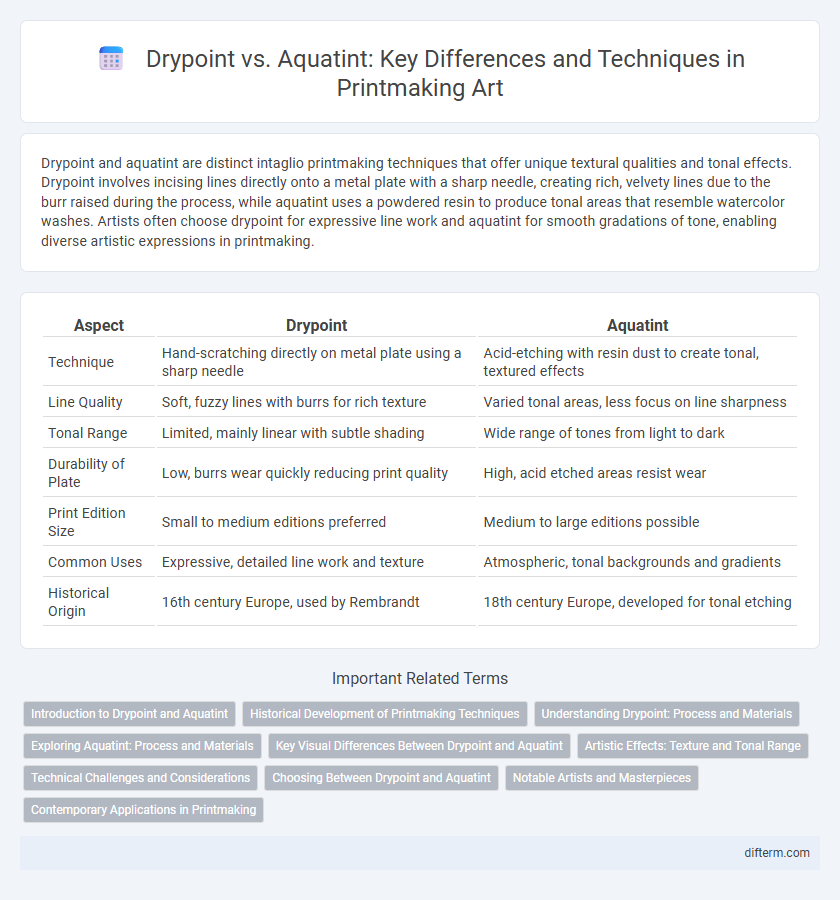Drypoint and aquatint are distinct intaglio printmaking techniques that offer unique textural qualities and tonal effects. Drypoint involves incising lines directly onto a metal plate with a sharp needle, creating rich, velvety lines due to the burr raised during the process, while aquatint uses a powdered resin to produce tonal areas that resemble watercolor washes. Artists often choose drypoint for expressive line work and aquatint for smooth gradations of tone, enabling diverse artistic expressions in printmaking.
Table of Comparison
| Aspect | Drypoint | Aquatint |
|---|---|---|
| Technique | Hand-scratching directly on metal plate using a sharp needle | Acid-etching with resin dust to create tonal, textured effects |
| Line Quality | Soft, fuzzy lines with burrs for rich texture | Varied tonal areas, less focus on line sharpness |
| Tonal Range | Limited, mainly linear with subtle shading | Wide range of tones from light to dark |
| Durability of Plate | Low, burrs wear quickly reducing print quality | High, acid etched areas resist wear |
| Print Edition Size | Small to medium editions preferred | Medium to large editions possible |
| Common Uses | Expressive, detailed line work and texture | Atmospheric, tonal backgrounds and gradients |
| Historical Origin | 16th century Europe, used by Rembrandt | 18th century Europe, developed for tonal etching |
Introduction to Drypoint and Aquatint
Drypoint is an intaglio printmaking technique where an image is incised directly onto a metal plate with a sharp needle, creating rich, velvety lines due to the burr raised by the engraving. Aquatint involves etching a plate with acid to produce tonal effects, allowing artists to create varied shades and textures similar to watercolor washes. Both methods are valued for their unique contributions to depth and detail in printmaking.
Historical Development of Printmaking Techniques
Drypoint emerged during the Renaissance as an intaglio printmaking technique characterized by scratching images onto a metal plate, allowing for expressive line work and rich textures. Aquatint developed later in the 18th century, innovated by artists like Jean-Baptiste Le Prince, to achieve tonal variations resembling watercolor washes through the application of powdered resin and acid baths. These advancements significantly expanded artistic possibilities in printmaking, blending precise lines with nuanced shading to enhance visual storytelling.
Understanding Drypoint: Process and Materials
Drypoint etching involves incising a design onto a metal plate with a sharp needle, creating burrs that hold ink and produce a characteristically rich, velvety line. The process typically uses copper or zinc plates, where artists draw directly onto the surface without acid, contrasting with other intaglio techniques. Mastery of pressure and needle angle is crucial in drypoint to achieve varying line depths and textures essential for detailed expression in prints.
Exploring Aquatint: Process and Materials
Aquatint is an intaglio printmaking technique that employs powdered resin applied to a metal plate, which is then heated to adhere the particles, creating tonal effects through acid etching. This method allows artists to achieve rich gradients and textured shades, distinguishing it from the sharper, linear incisions of drypoint. Materials such as copper or zinc plates, rosin powder, and acid baths are essential to the aquatint process, enabling the creation of nuanced prints with varied depth and atmosphere.
Key Visual Differences Between Drypoint and Aquatint
Drypoint creates rich, velvety lines with a characteristic burr that produces a soft, raised texture on the paper, resulting in deep, expressive marks. Aquatint, on the other hand, uses a powdered resin to create tonal effects, producing gradients and areas of flat, subtle shading rather than distinct lines. The key visual difference lies in drypoint's linear, textured quality versus aquatint's smooth, tonal washes that mimic watercolor or ink wash effects.
Artistic Effects: Texture and Tonal Range
Drypoint creates rich, velvety textures with deep, expressive lines due to the burr raised by the needle, producing a unique tactile quality in prints. Aquatint, on the other hand, excels in achieving smooth tonal gradients and subtle shading, enabling artists to mimic watercolor-like washes and nuanced depth. Both techniques offer distinct artistic effects: drypoint emphasizes bold, textural contrasts, while aquatint enhances tonal complexity and atmospheric subtlety.
Technical Challenges and Considerations
Drypoint etching demands precise hand control to incise fine lines directly onto the copper plate, where the burr created adds rich, velvety textures but wears down quickly, limiting print runs. Aquatint requires careful application of resin particles and acid baths to achieve tonal variation, with strict timing needed to avoid over-etching or uneven tones. Both techniques necessitate mastery of plate preparation and timing to balance artistic intent with the physical limitations of materials and tooling.
Choosing Between Drypoint and Aquatint
Choosing between drypoint and aquatint depends on the desired texture and tonal range in the artwork. Drypoint offers rich, velvety lines created by scratching directly onto the plate, ideal for bold, expressive marks. Aquatint provides nuanced shading and gradient effects through acid etching, making it suitable for detailed tonal variations and atmospheric depth.
Notable Artists and Masterpieces
Drypoint techniques were famously used by Rembrandt, whose mastery in creating rich, velvety lines is evident in masterpieces like "The Three Crosses." Aquatint gained prominence through Francisco Goya, who utilized its tonal variations to produce haunting images in his series "Los Caprichos." Both methods remain pivotal in printmaking, showcasing distinct approaches to line and tone by master artists.
Contemporary Applications in Printmaking
Drypoint and aquatint are both intaglio printmaking techniques, with drypoint known for its rich, velvety lines created by scratching a copper or zinc plate, while aquatint excels in producing tonal variations through acid etching. Contemporary printmakers often combine drypoint's expressive linear qualities with aquatint's gradated tones to achieve complex textures and depth in mixed-media artworks. This hybrid approach enables innovative explorations in texture and mood, reflecting current trends in experimental printmaking practices.
Drypoint vs Aquatint Infographic

 difterm.com
difterm.com